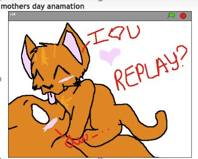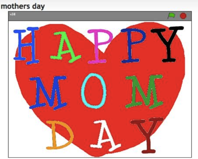
Let me start with a story….
A few years ago, on the day before Mother’s Day, I suddenly realized that I hadn’t gotten a gift for my mom. So I started thinking about last-minute gifts. Instead of buying a gift, I decided to make an interactive Mother’s Day card for my mom, using the Scratch programming software developed by my research group at the MIT Media Lab.
Before starting to create my Mother’s Day card, I decided to check out the Scratch community website, looking for inspiration. People have programmed and shared more than six million projects on the Scratch website. I wondered if anyone else had programmed a Mother’s Day. So I typed “Mother’s Day” in the search box, and pressed Return.
I was surprised and delighted to see a list of dozens and dozens of Mother’s Day cards, most of them created by young people between the ages of 8 and 16. I checked the dates on the projects, and I saw that most of them had been created in the past couple days, by procrastinators like myself.
I began clicking on the links to play with some of the projects. One of the projects was a short animation featuring a kitten and a larger cat. The kitten turns around, sees the larger cat, and shouts out “MOMMIE!” Then, the kitten joyfully jumps on the big cat, knocks her over, and says “I ♥ U”. At the end of the animation, the creator added a replay option, so that her mother could view the animation again (and again and again).


Another project started with the words “HAPPY MOM DAY” drawn on top of a large red heart. Each of the 11 letters was interactive, transforming to a word when touched by the mouse. As I moved the mouse across the screen, touching each letter, a special 11-word Mother’s Day message was revealed: “I love you and care for you. Happy Mother’s Day mom.”
As I played with the Mother’s Day projects, I felt a sense of satisfaction. This was exactly what our team at the Media Lab had hoped for when we developed Scratch. We hoped that young people would use Scratch as a means of personal expression, as a new way to express their ideas and communicate with others.
We’ve been excited by the incredible variety of projects that young people have created with Scratch. Take a look at the Scratch website and you’ll find animated stories, video games, virtual tours, science simulations, online newsletters, interactive tutorials, and much more – all created through coding with Scratch.
We view coding as a new type of literacy, similar to writing. People use writing in all parts of their lives: to send messages to friends, to create shopping lists, to record personal feelings in diaries. The act of writing also engages people in new ways of thinking. As people write, they learn to organize, refine, and reflect on their ideas. Writing is important for everyone, not just people who plan to become professional writers.
Similarly, we think coding should be for everyone, not just people who want to get jobs as professional programmers or computer scientists. In the process of learning to code, people learn many other things. They learn strategies for solving problems, designing projects, and communicating ideas. These skills are useful for everyone, regardless of age, interests, or occupation.
Many people associate coding with logical thinking and systematic reasoning – and, indeed, that’s true. But learning to code can also help young people develop as creative thinkers. The diverse collection of stories, games, and animations (and, yes, Mother’s Day cards) on the Scratch website serves as evidence for the creative possibilities of coding.
In today’s fast-changing world, nothing is more important than the ability to think and act creatively. How can we help young people develop as creative thinkers? By giving them opportunities to create. Although most young people already spend lots of time interacting with computers (playing games, chatting with friends, exploring virtual worlds, searching for information online), most of them have little experience creating with computers. They feel comfortable playing with interactive games, animations, and simulations, but not creating their own. As young people create and share Scratch projects, they are developing as creative thinkers – and, in the process, becoming prepared for a world that requires creative thinking more than ever before.


